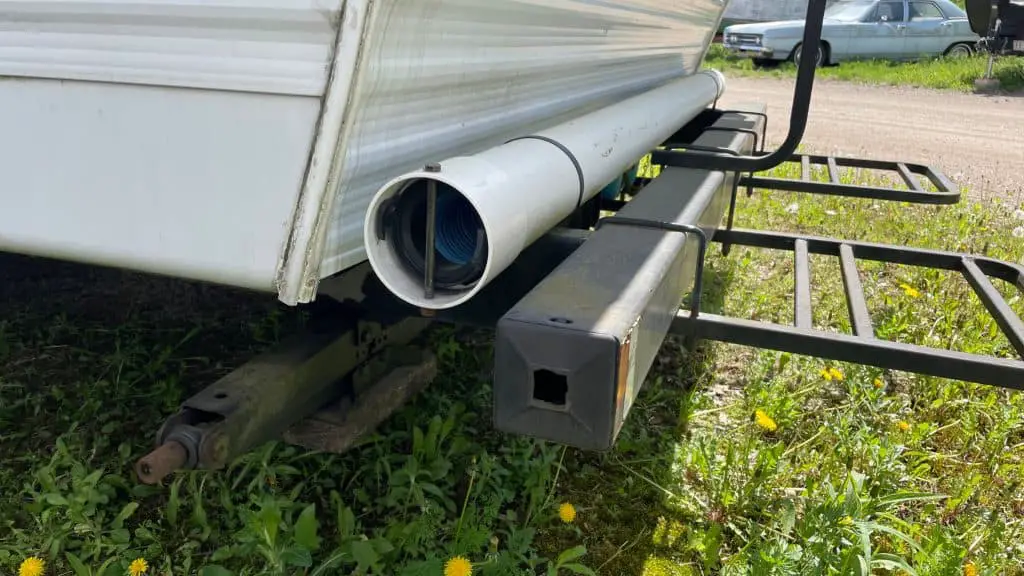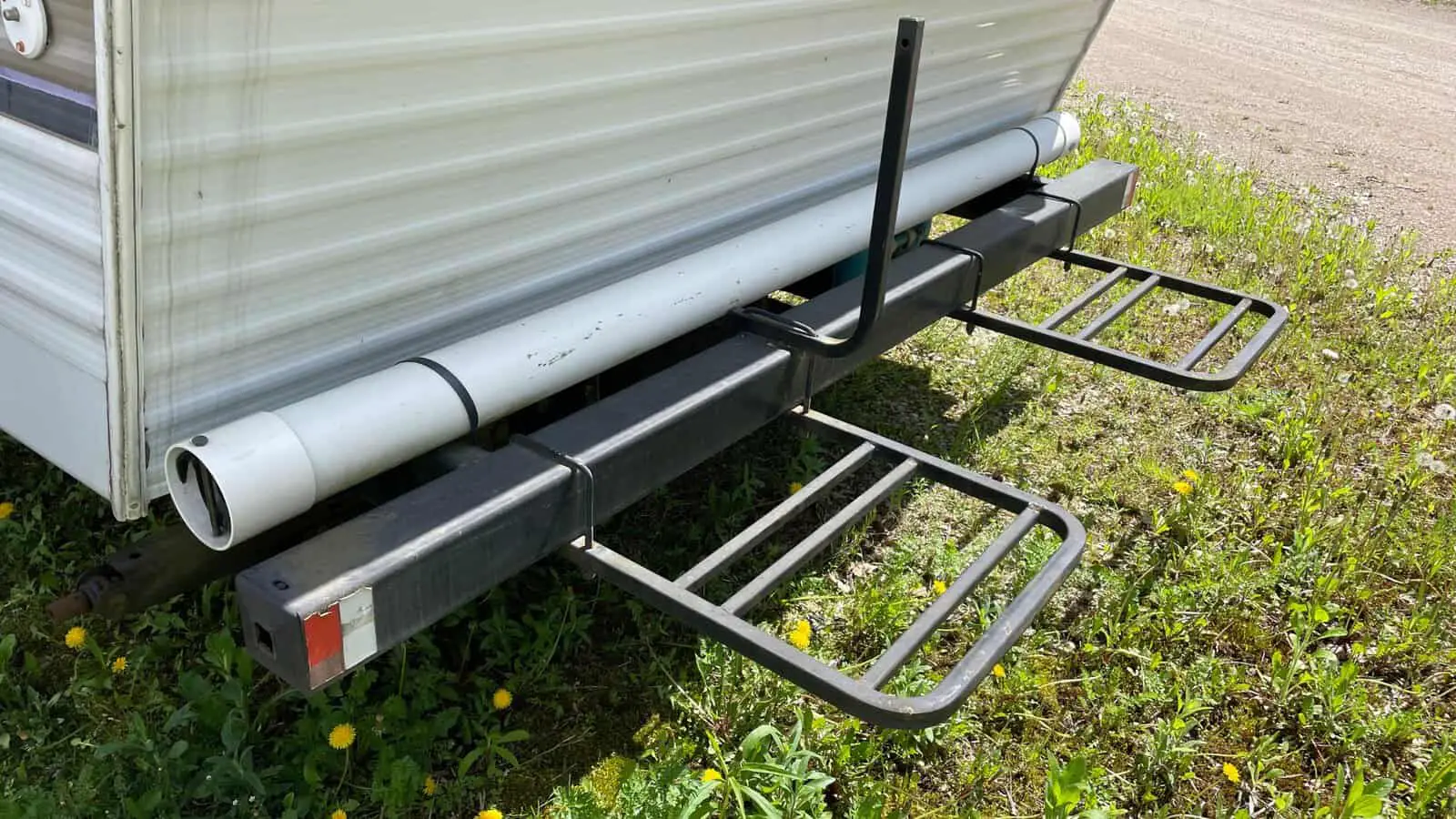Properly managing your RV’s sewer hose system is a crucial part of a pleasant and hygienic camping experience. To ensure a clean and organized camper environment, we’ve compiled a list of top sewer hose storage solutions and DIY hacks. Let’s dive in!
1. Commercial Sewer Hose Storage Options
There are various sewer hose storage options available on the market that cater to different budgets and preferences. Here are some top choices:
a. Hose Carriers
Hose carriers are affordable and straightforward solutions to store your sewer hose safely. They are typically made of durable materials like PVC and can be mounted under your RV for easy access.
b. Storage Tubes
Storage tubes offer a more robust solution and can be attached to your RV’s bumper or undercarriage. These tubes keep your sewer hose clean and protected from the elements while traveling.
Take a look at our article on: 8 Best RV Sewer Hose Support Options: (For Proper Draining And Flow)
2. DIY Sewer Hose Storage Solutions
For those who prefer a hands-on approach, here are some creative DIY hacks for sewer hose storage:
a. PVC Pipe Storage
Using a large-diameter PVC pipe, you can create a custom storage solution by cutting the pipe to the desired length and adding end caps. Mount this DIY storage tube under your RV or on the bumper using brackets or straps.
b. Rain Gutter Storage Tray
Repurpose a vinyl rain gutter by cutting it to the length of your sewer hose and attaching end caps. Mount this innovative storage tray in your RV’s storage compartment, making sure to secure it with brackets or straps.
c. Hidden Storage Compartment
If you have unused space under your RV, create a hidden storage compartment by attaching a hinged door to the underside. Store your sewer hose in this secret compartment and keep it out of sight when not in use.

3. Maintenance and Sanitation
To ensure a clean and hygienic RV environment, follow these tips for maintaining and sanitizing your sewer hose:
- After each use, thoroughly rinse the sewer hose with fresh water.
- Use a high-quality RV black tank cleaner to break down waste and prevent odors.
- Regularly inspect your sewer hose for cracks, leaks, or other signs of wear and tear.
- Replace your sewer hose as needed to avoid any unpleasant surprises during your camping trips.
4. Sewer Hose Accessories for a Smooth Camping Experience
To further improve your RV sewer system management, consider investing in some essential sewer hose accessories:
a. Sewer Hose Support
Sewer hose supports keep your hose off the ground and allow for a smooth, downhill flow of waste, preventing clogs and making the dumping process more efficient. These supports come in various styles, such as accordion-style or slinky-type.
b. Sewer Hose Extensions
For those instances when your standard sewer hose doesn’t quite reach the campground’s dump station, sewer hose extensions can save the day. Available in different lengths, these extensions are easy to connect and provide the extra reach you need.
c. Sewer Hose Fittings and Adapters
Having the right sewer hose fittings and adapters ensures a secure and leak-free connection between your RV’s waste outlet and the campground’s sewer inlet. Look for universal fittings that are compatible with various hose sizes and sewer inlets.
Take a look at our article on: 8 Best RV Sewer Hose Support Options: (For Proper Draining And Flow)
5. Proper Sewer Hose Storage Etiquette at Campgrounds
When staying at campgrounds, it’s essential to practice proper sewer hose storage etiquette to maintain a clean and pleasant environment for all campers:
a. Store Your Sewer Hose Properly
Always store your sewer hose in a designated storage compartment or solution when not in use. This practice keeps your campsite tidy and prevents any accidental contact with the hose.
b. Avoid Cross-Contamination
Never place your sewer hose near or on any surfaces used for food preparation or where people might sit or walk. Keep the hose contained in its storage solution when not in use to avoid cross-contamination.
c. Dispose of Waste Responsibly
Follow the campground’s guidelines for dumping waste and make sure to clean up any spills immediately. Using a black tank cleaner and thoroughly rinsing your sewer hose after each use will help prevent odors and maintain a clean campsite.
6. Choosing the Right Sewer Hose for Your RV
Selecting a high-quality sewer hose is crucial for an efficient and hassle-free RV waste management system. Here are some factors to consider when choosing a sewer hose:
a. Material and Durability
Look for sewer hoses made from heavy-duty, puncture-resistant materials, such as vinyl or reinforced PVC. These hoses will last longer and withstand the wear and tear of regular use.
b. Length and Compatibility
Consider the length of the sewer hose and ensure it is compatible with your RV’s waste outlet and the dump stations you will encounter. Having a sewer hose extension on hand can be beneficial for situations where additional length is needed.
c. Ease of Use and Storage
Opt for a sewer hose that is easy to use, clean, and store. Collapsible hoses save space and can be stored in compact storage solutions, while hoses with pre-attached fittings make connecting and disconnecting a breeze.
By choosing the right sewer hose storage solution and maintaining proper sanitation practices, you can enjoy a clean and organized camper experience.
Good luck, and happy camping!
Check out our article on: Best RV Sewer Hoses For 2023 (5 Kits Reviewed)

